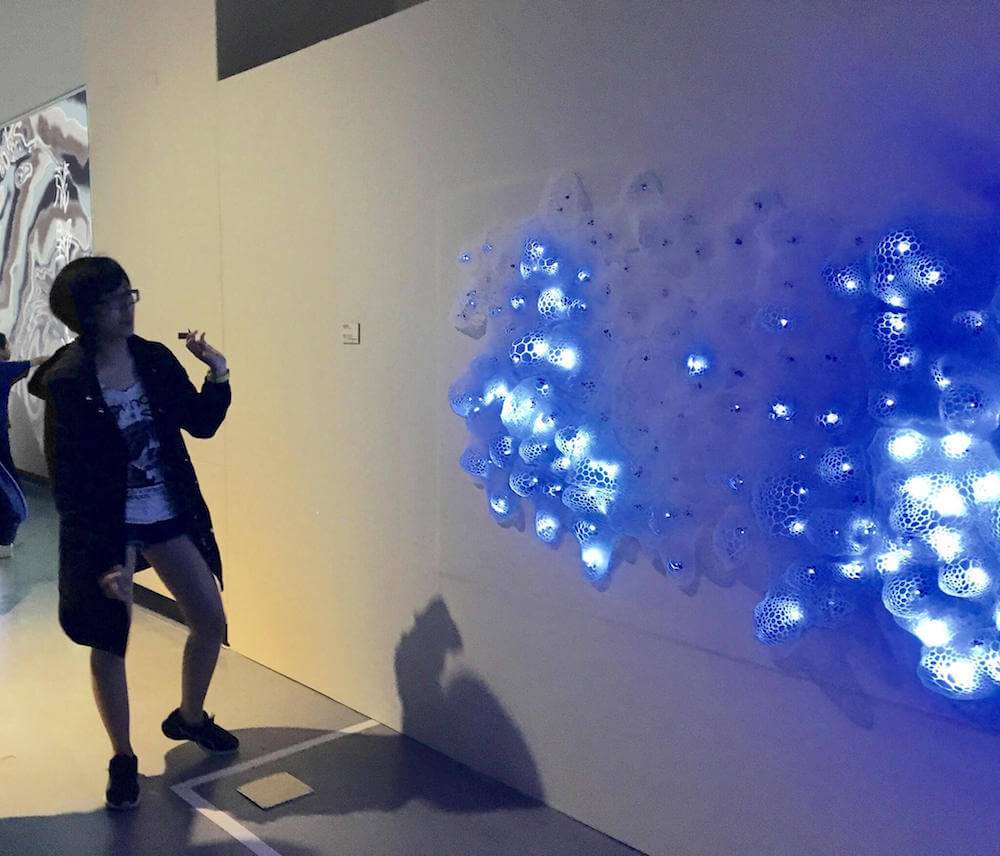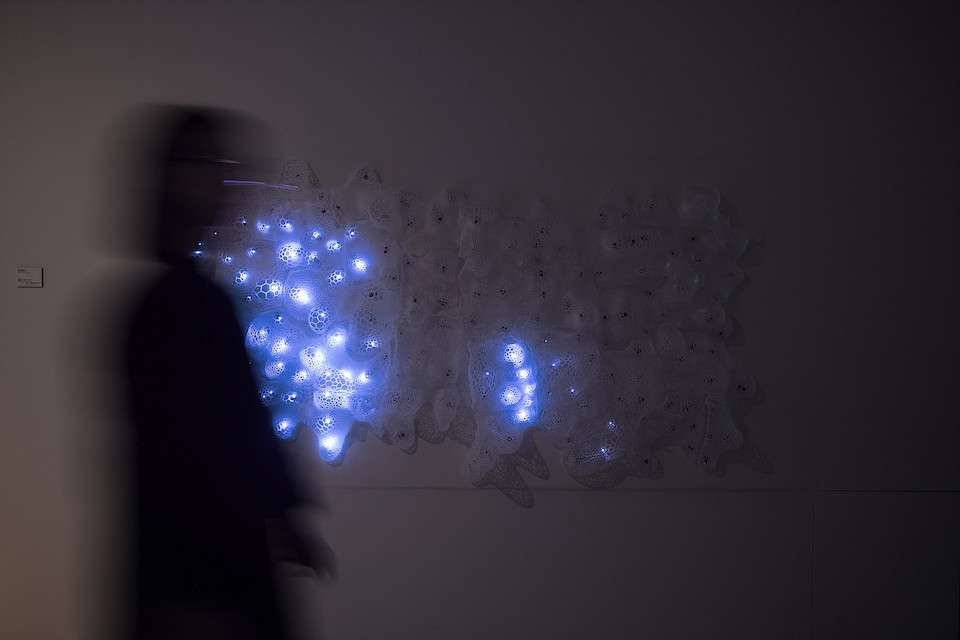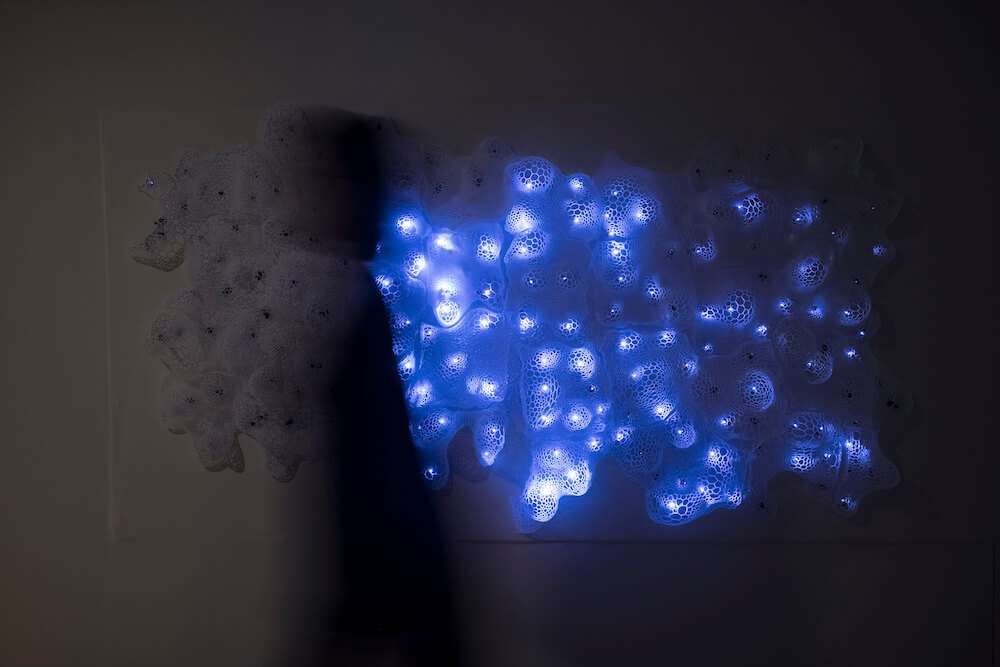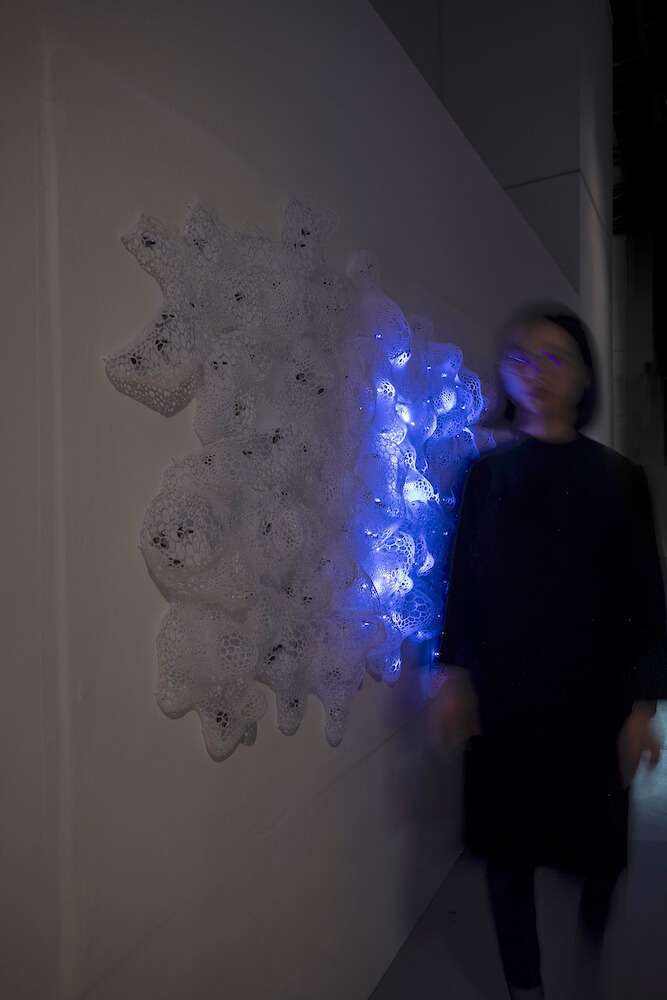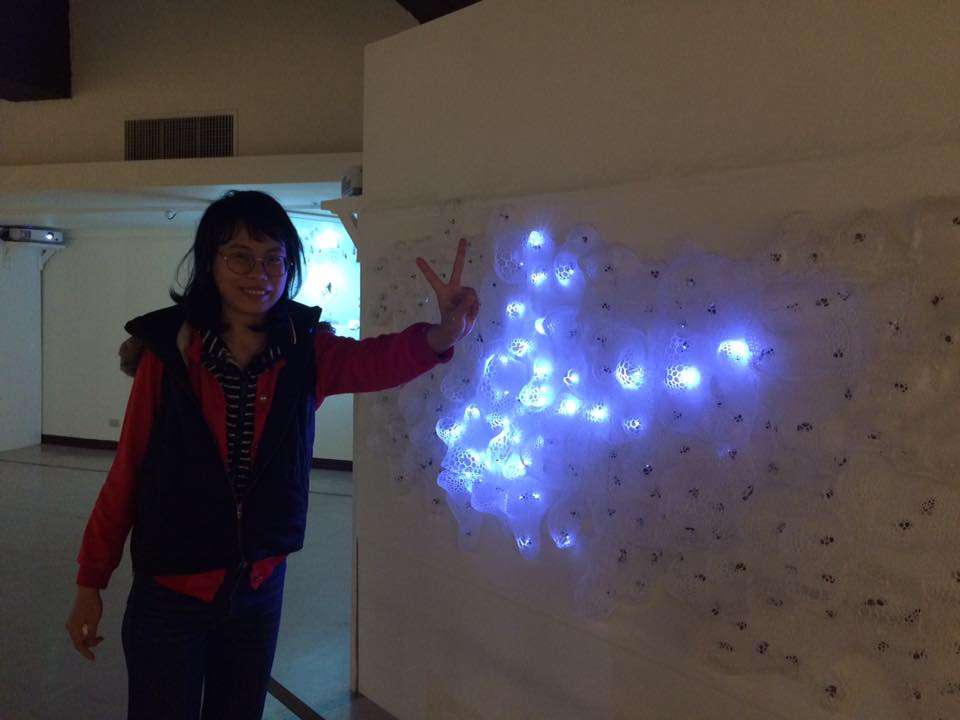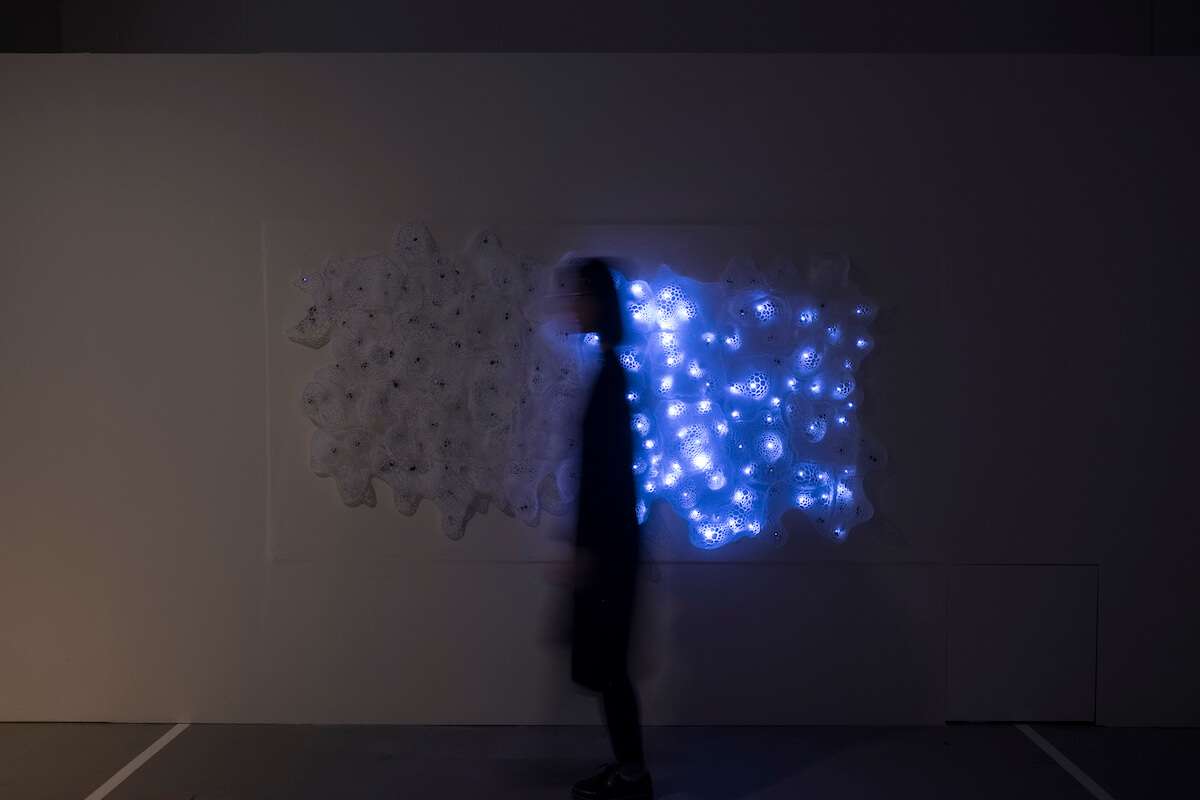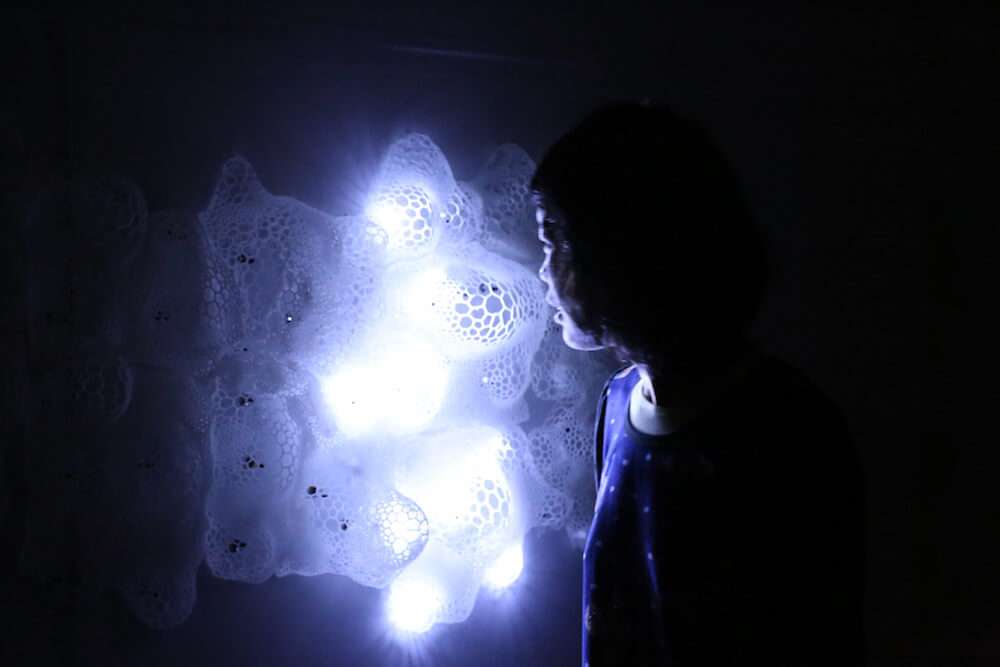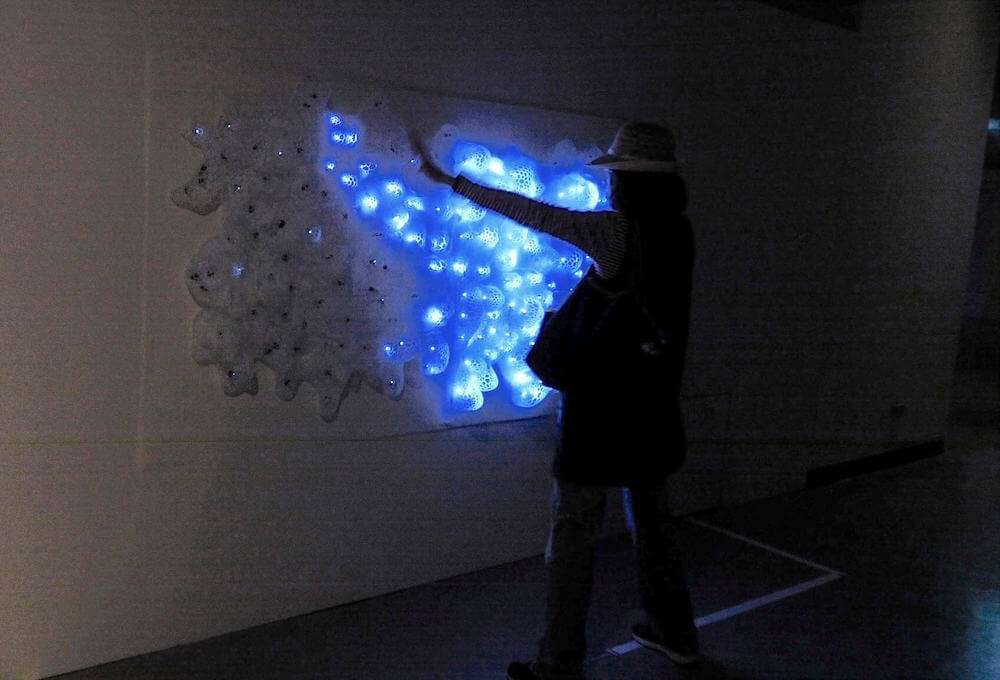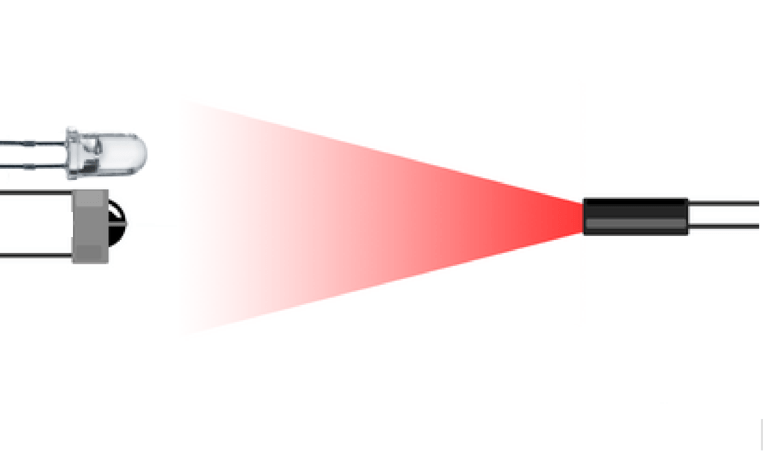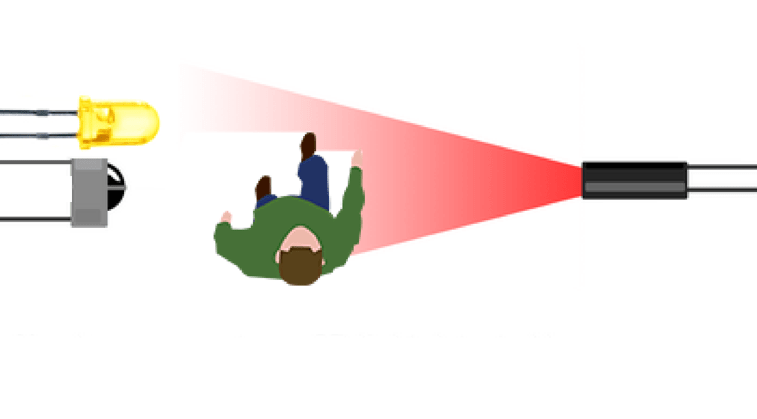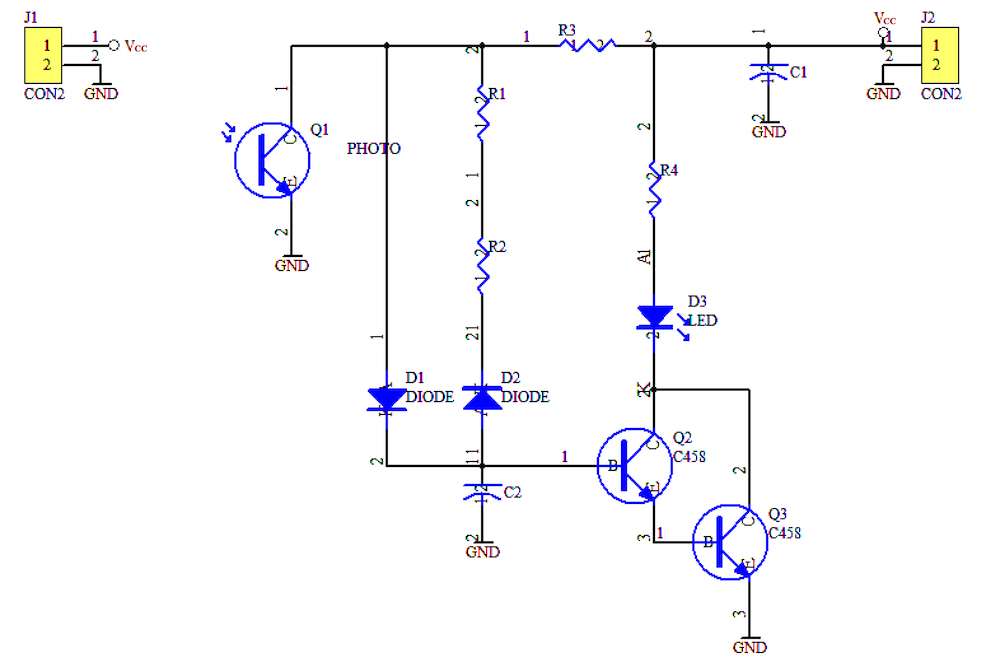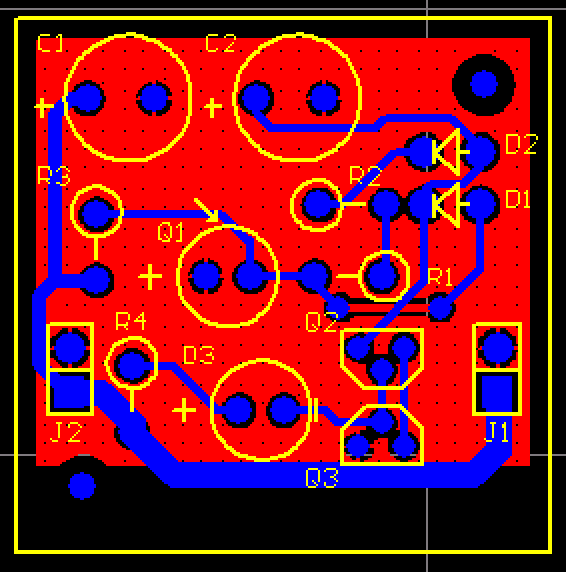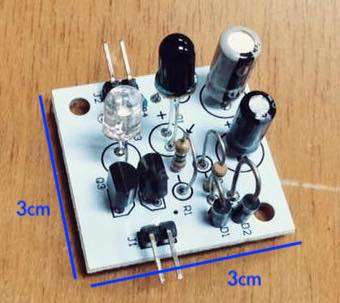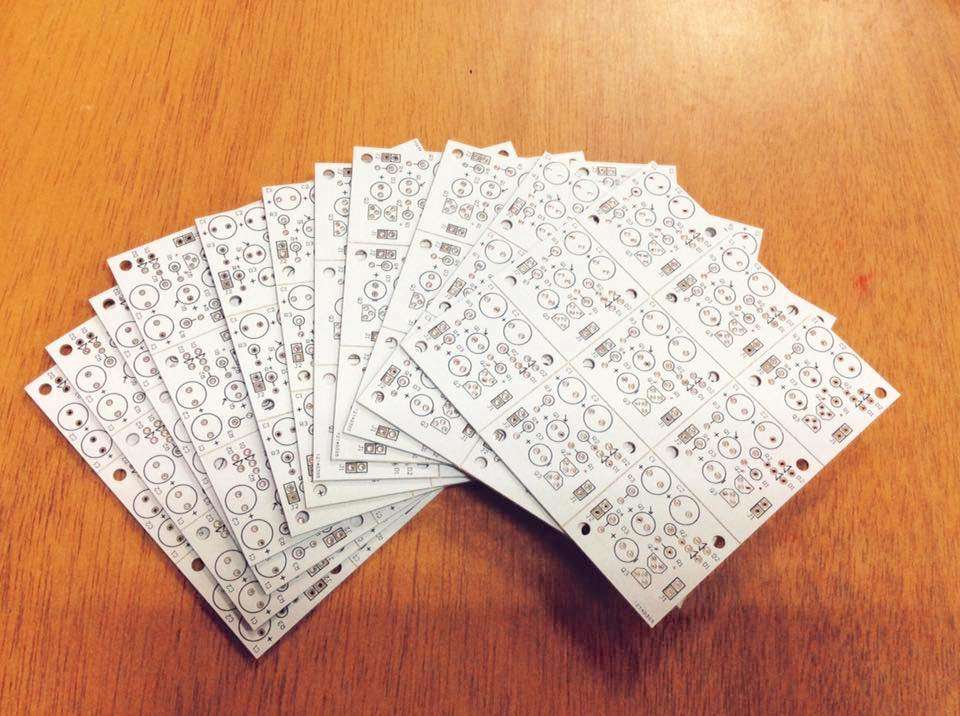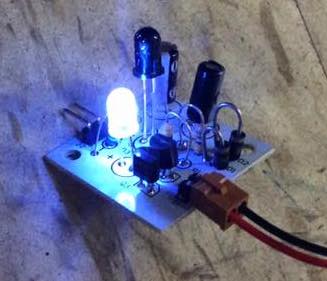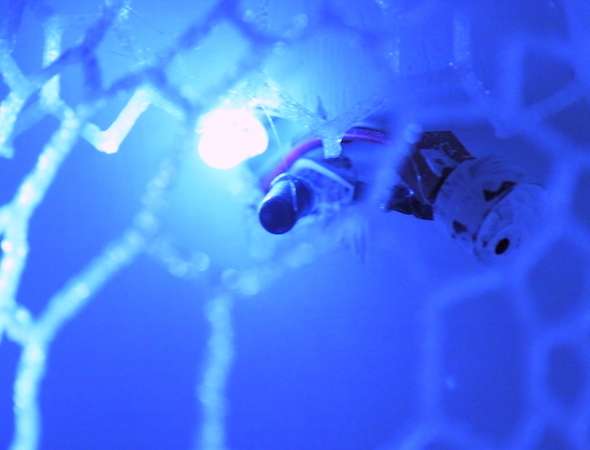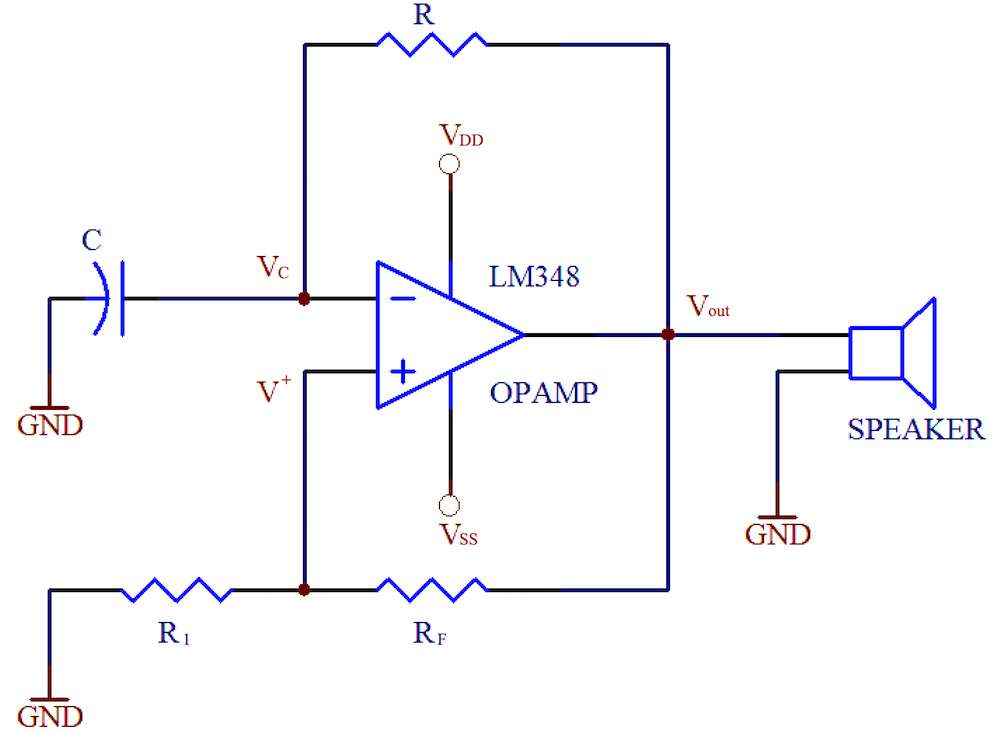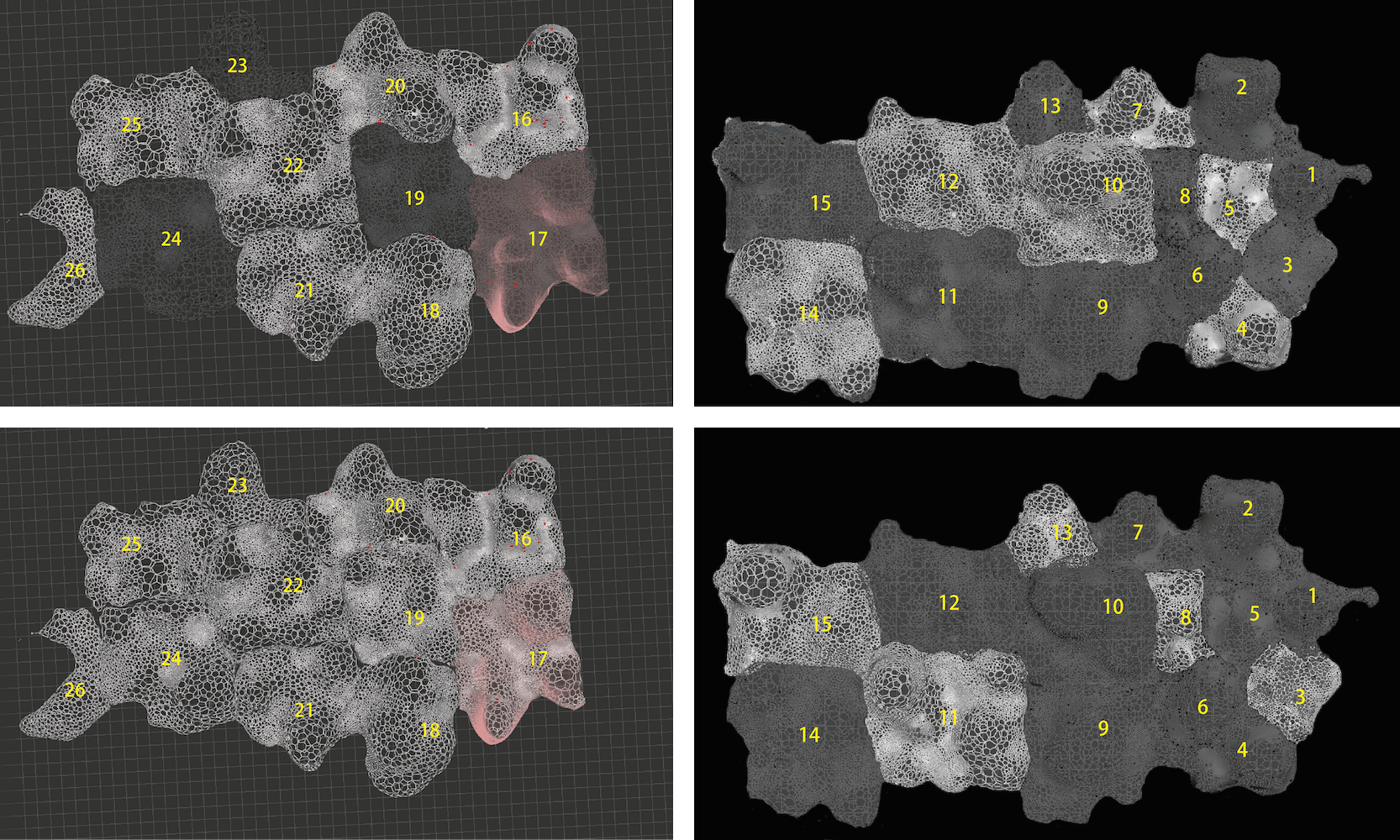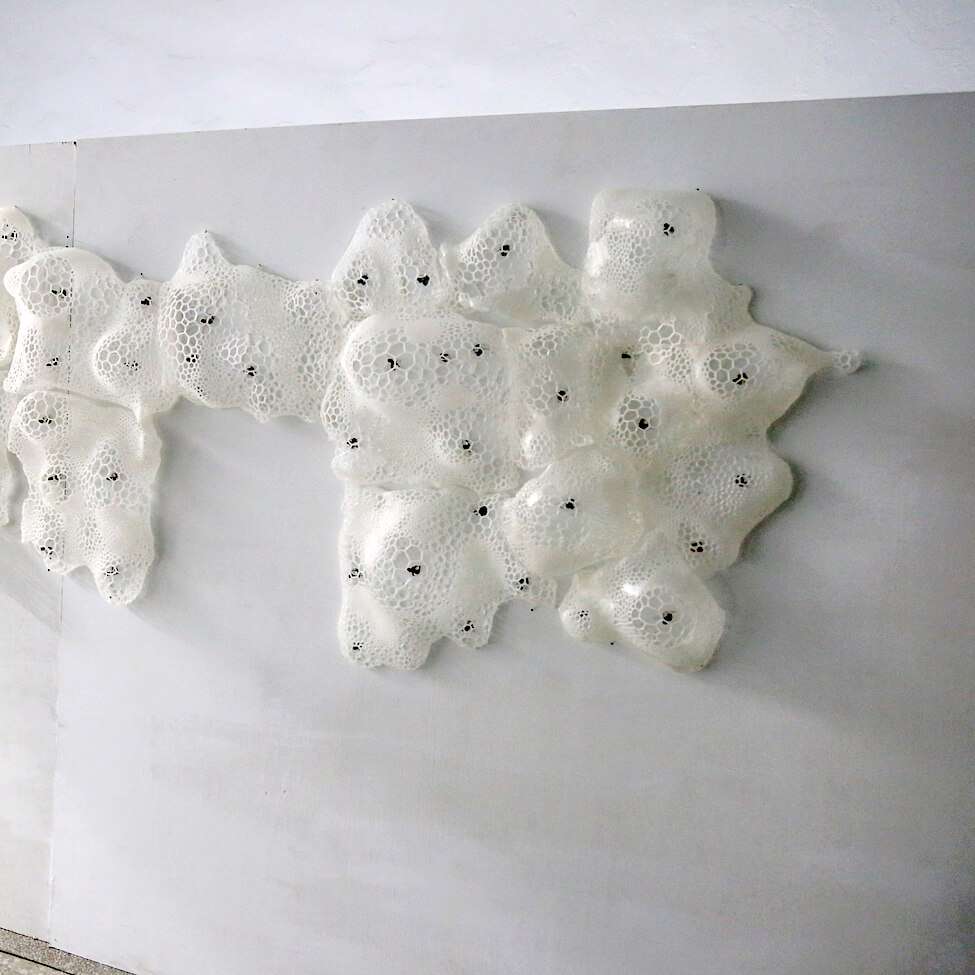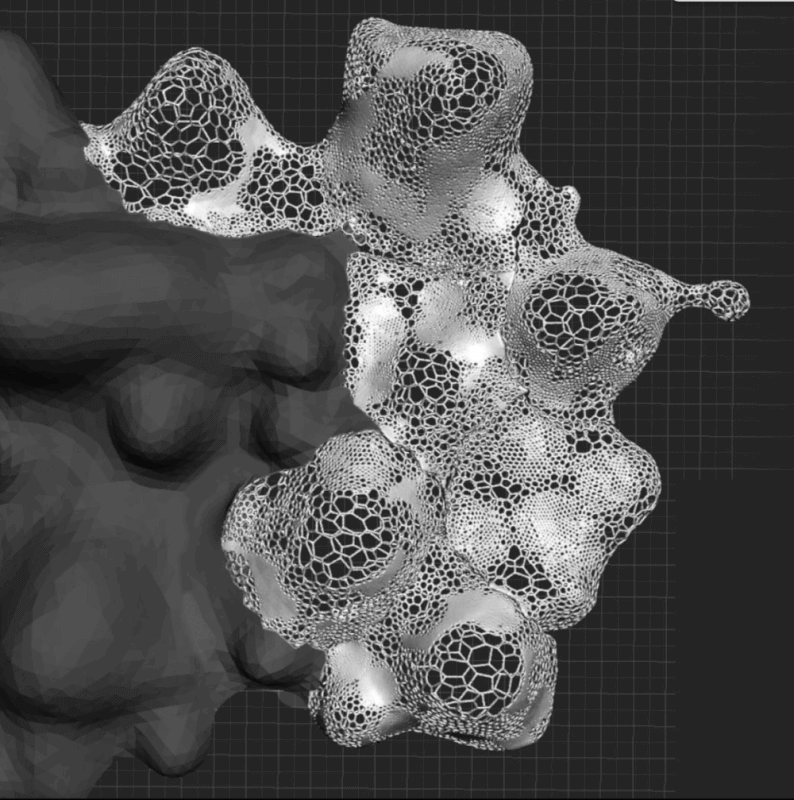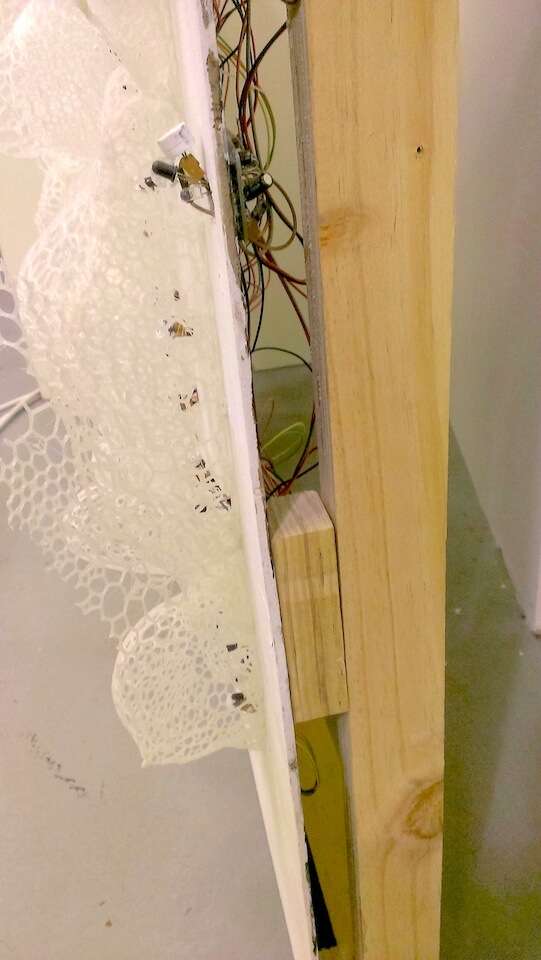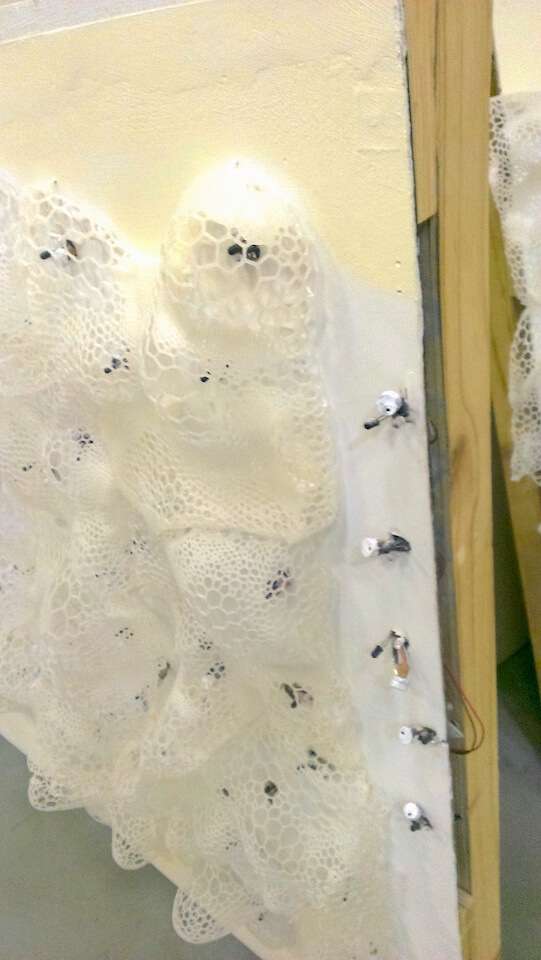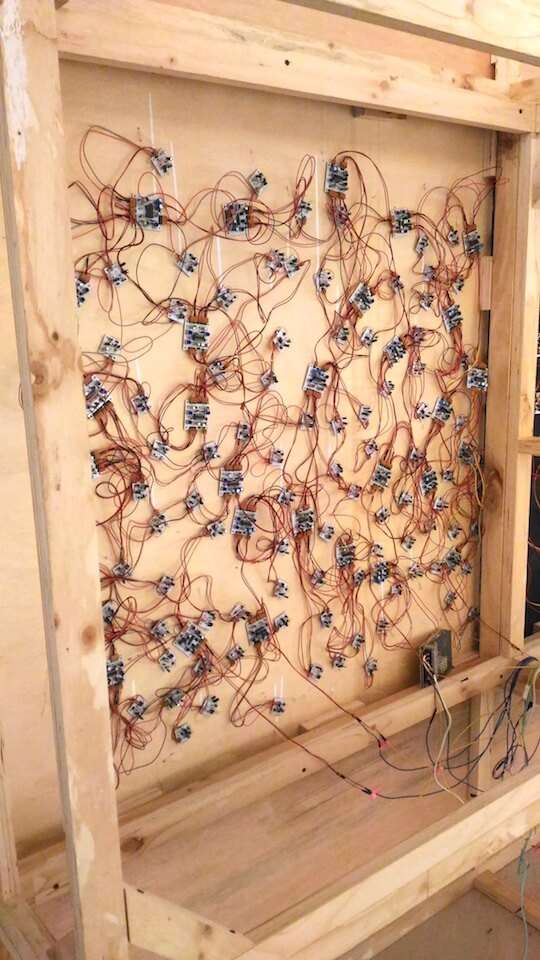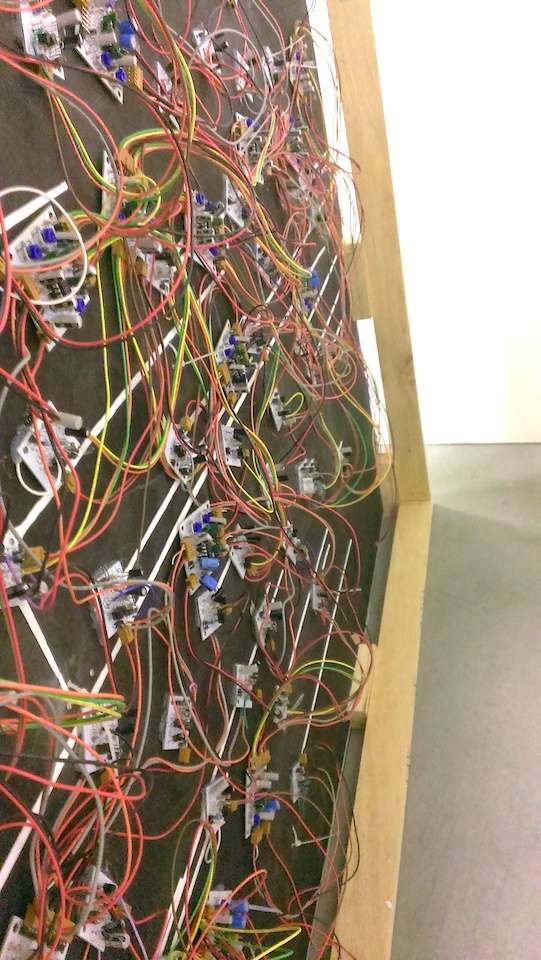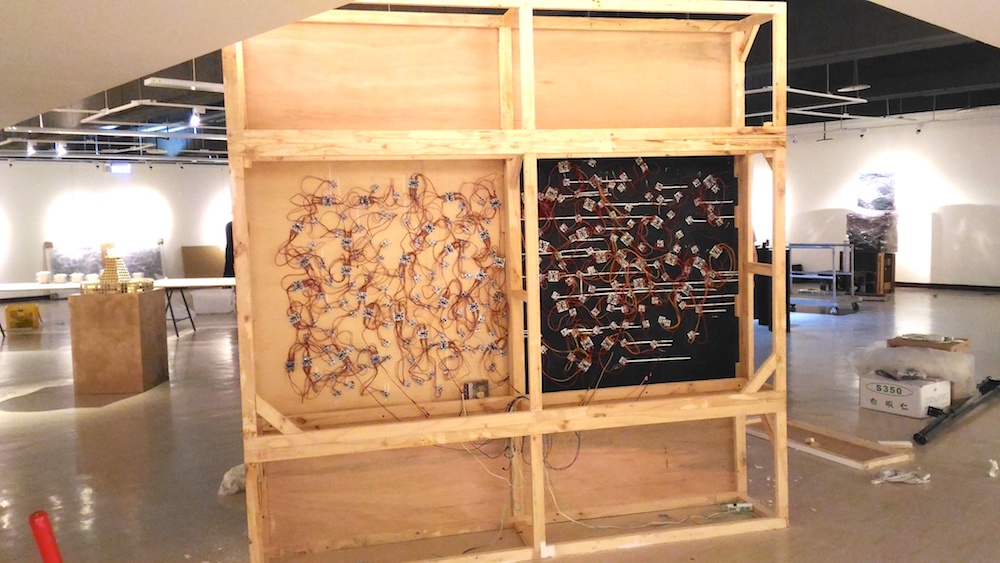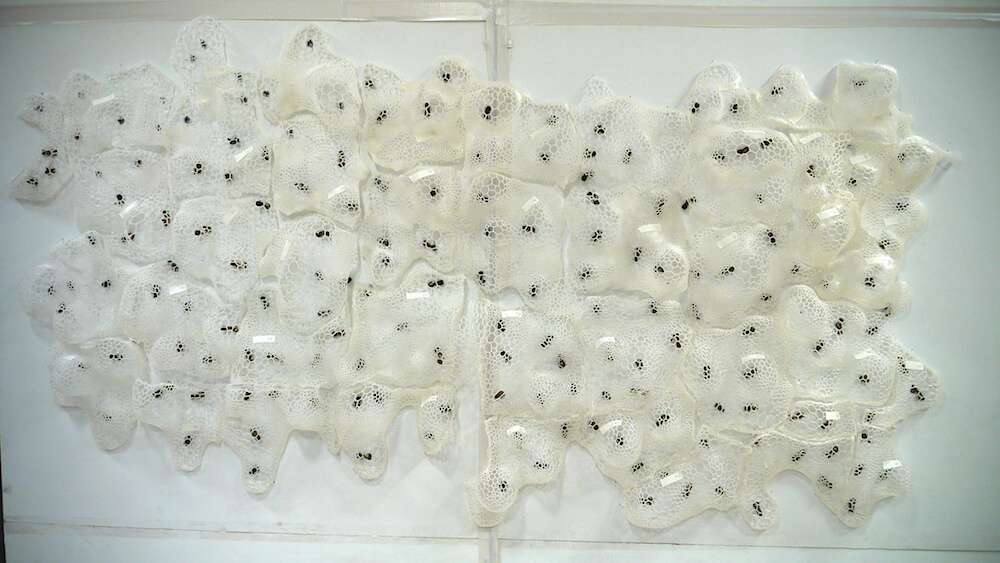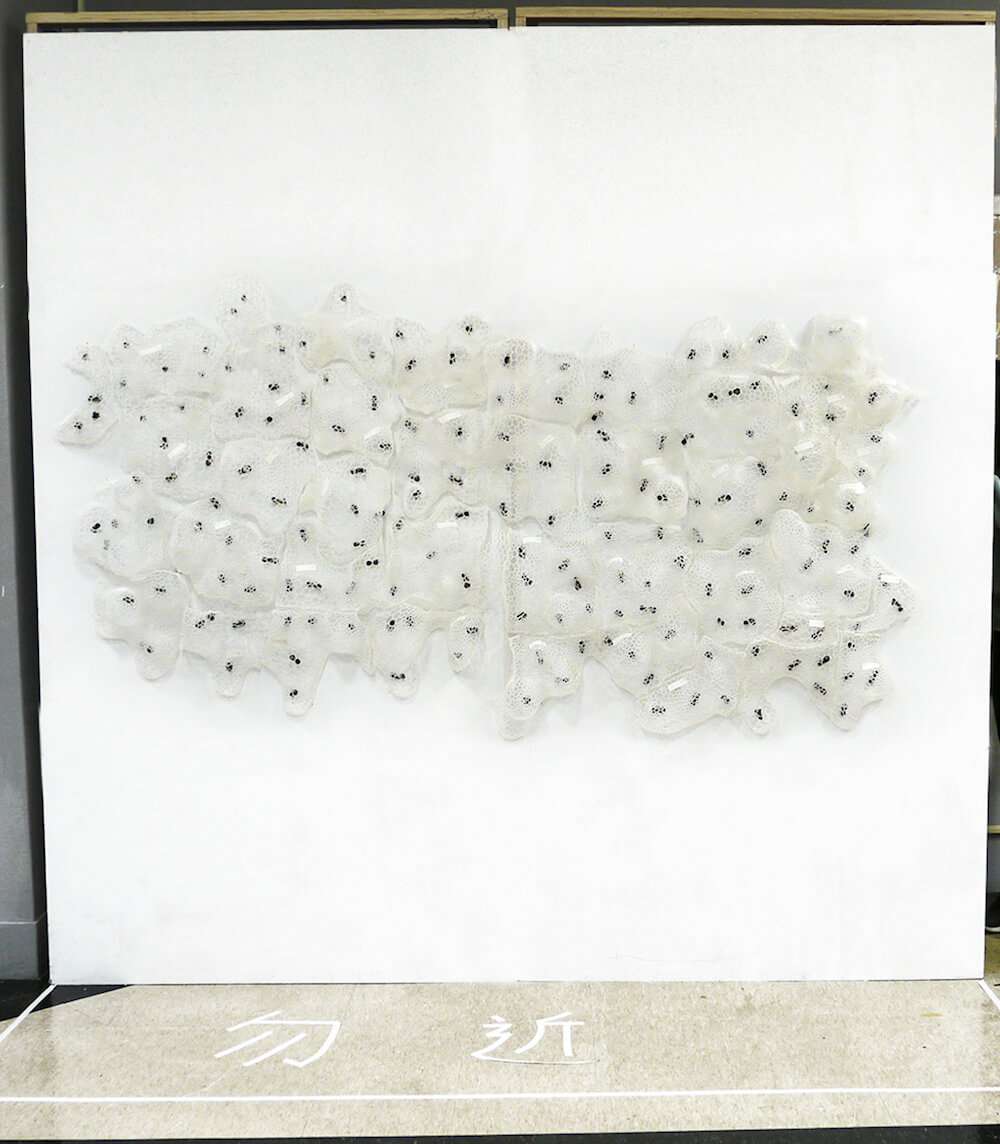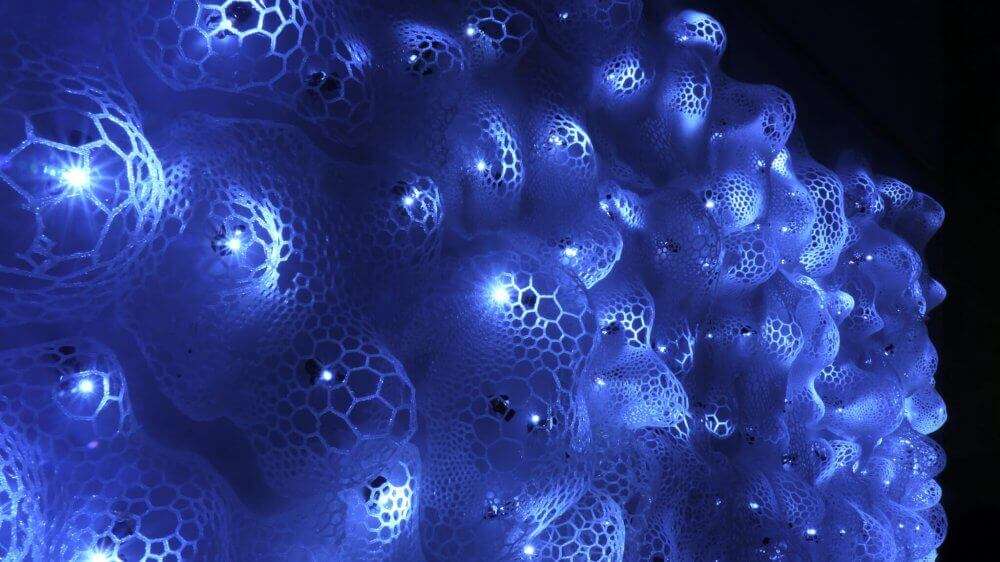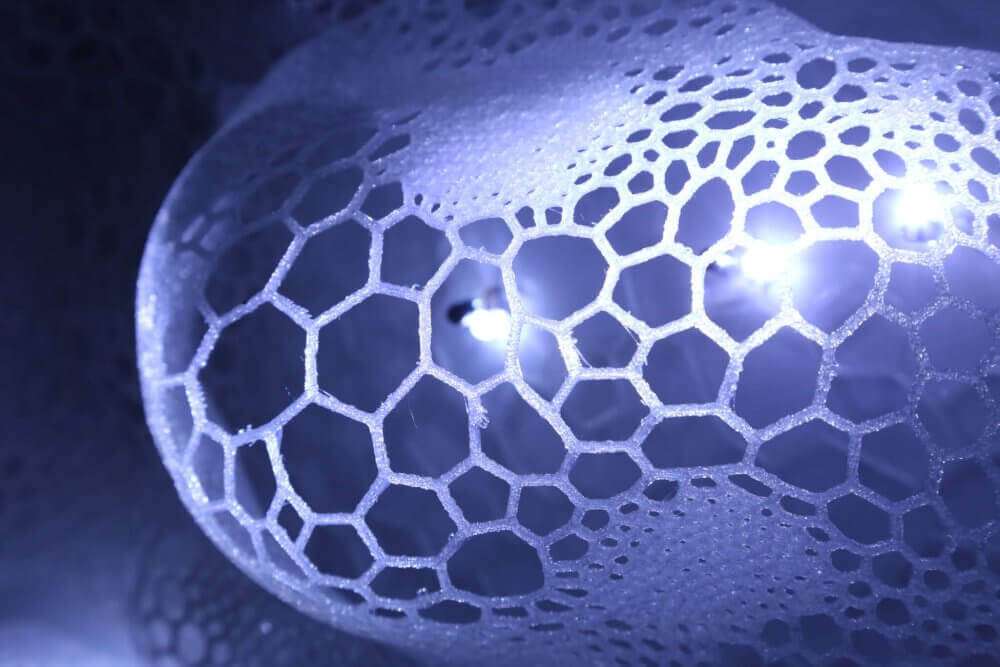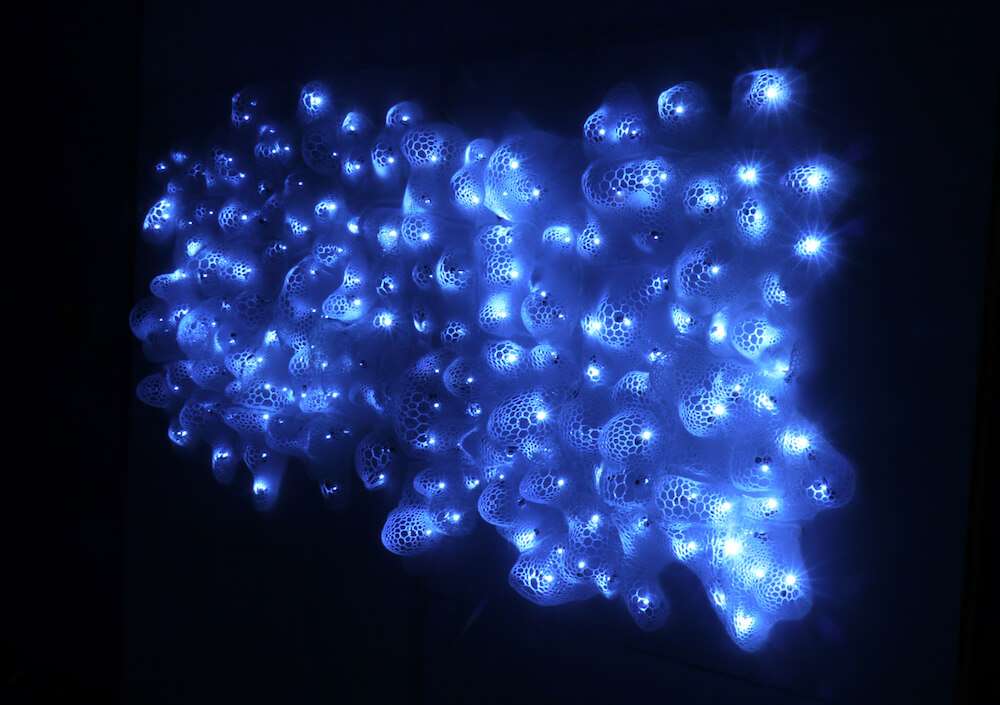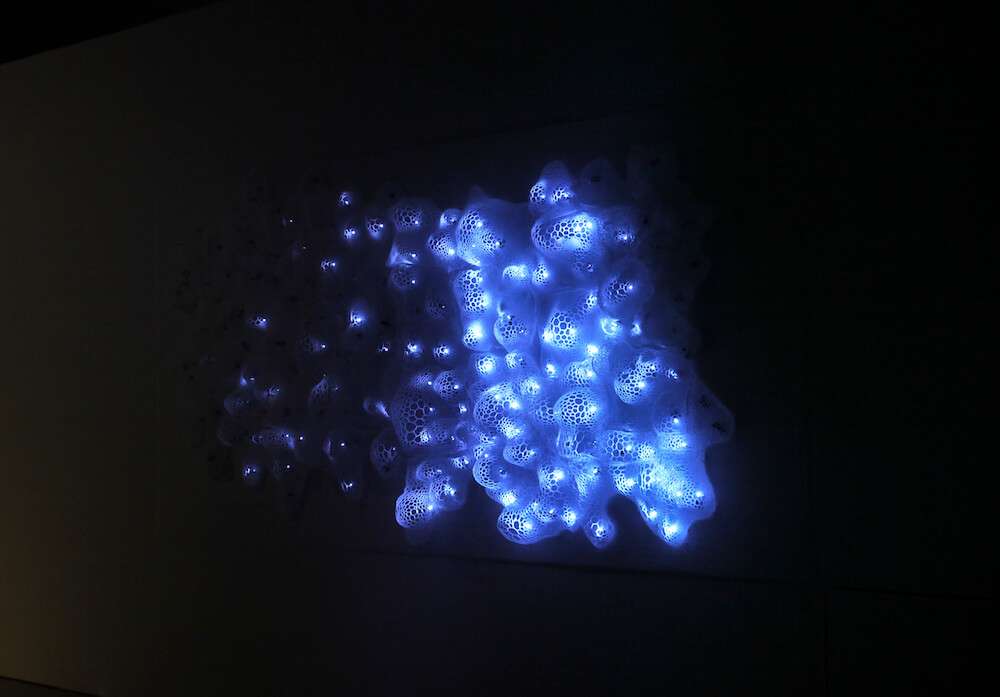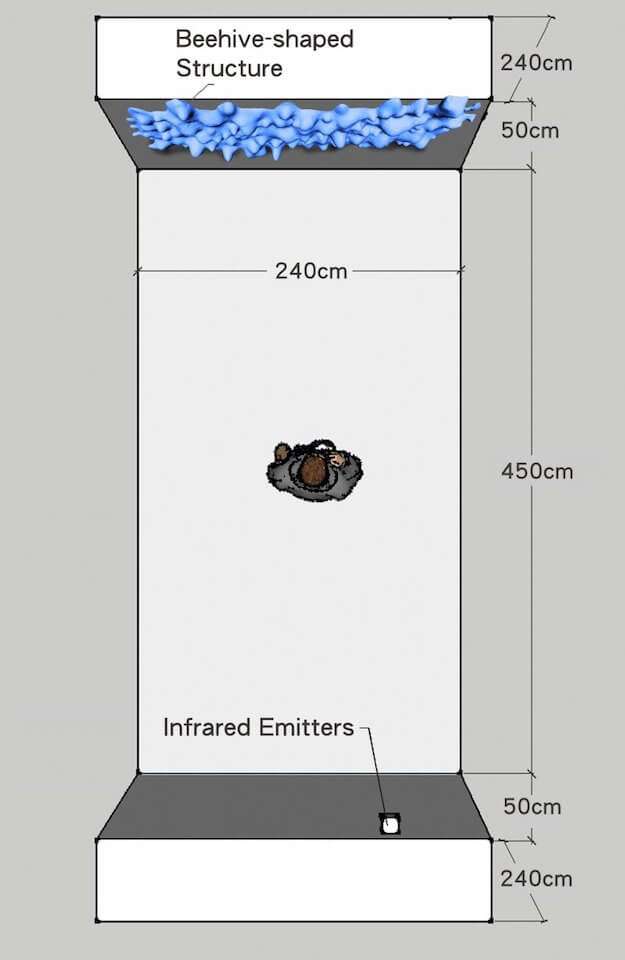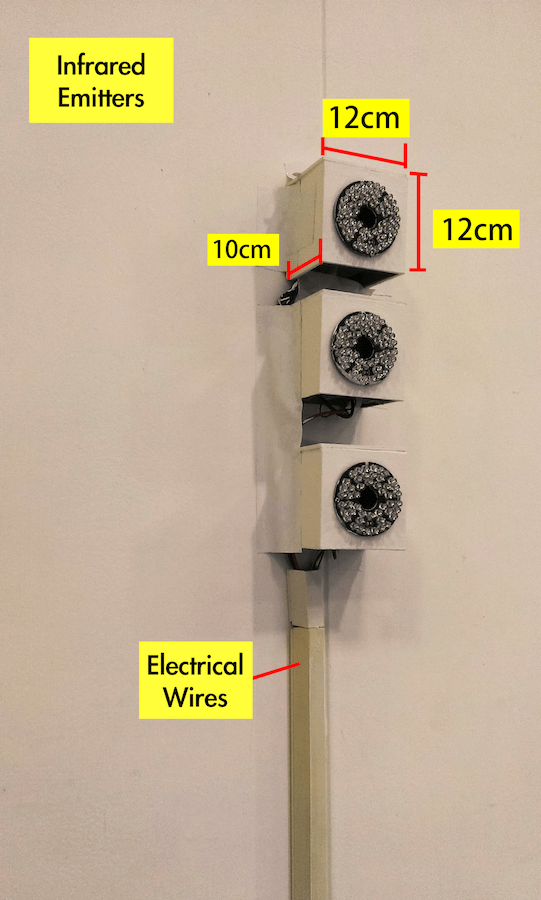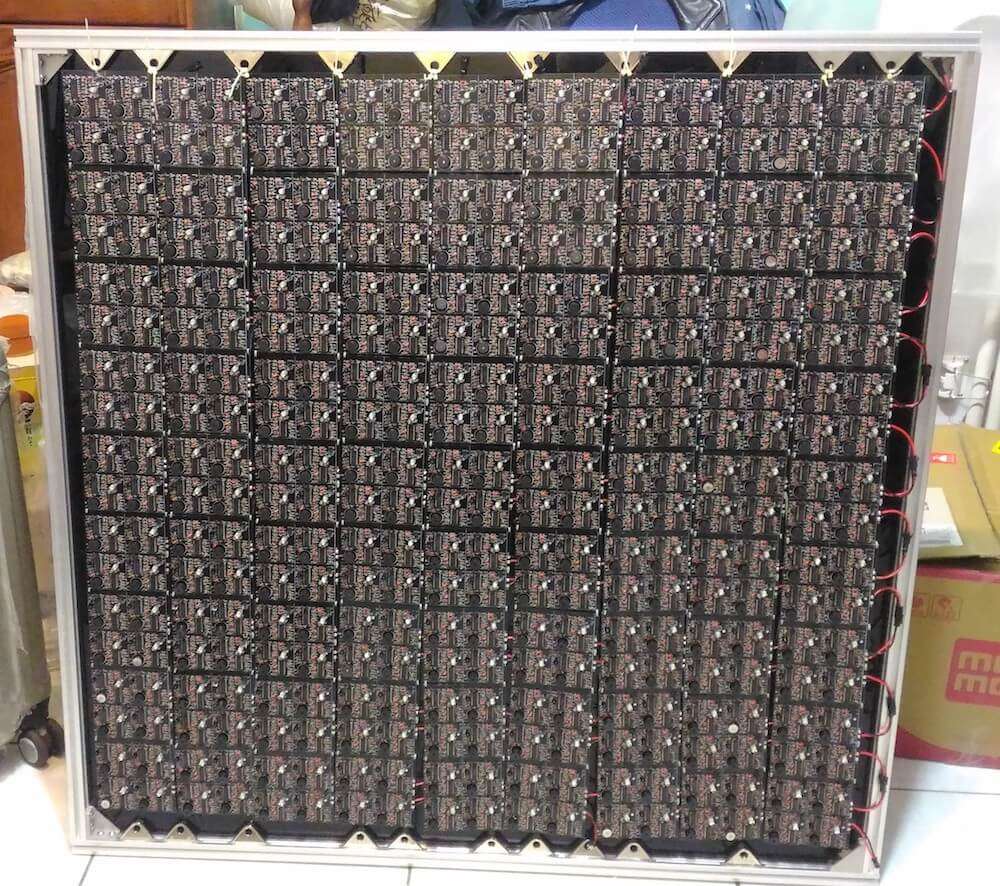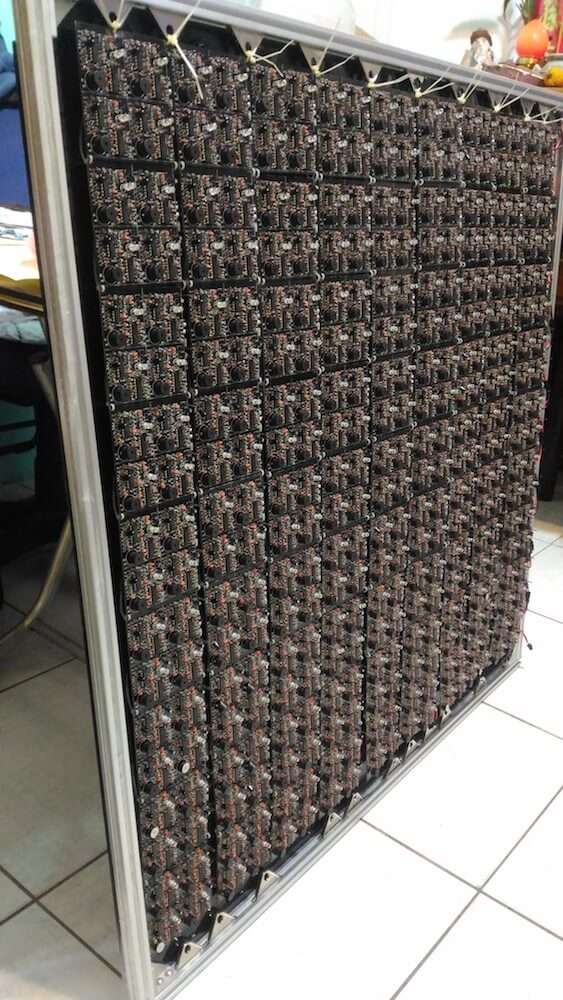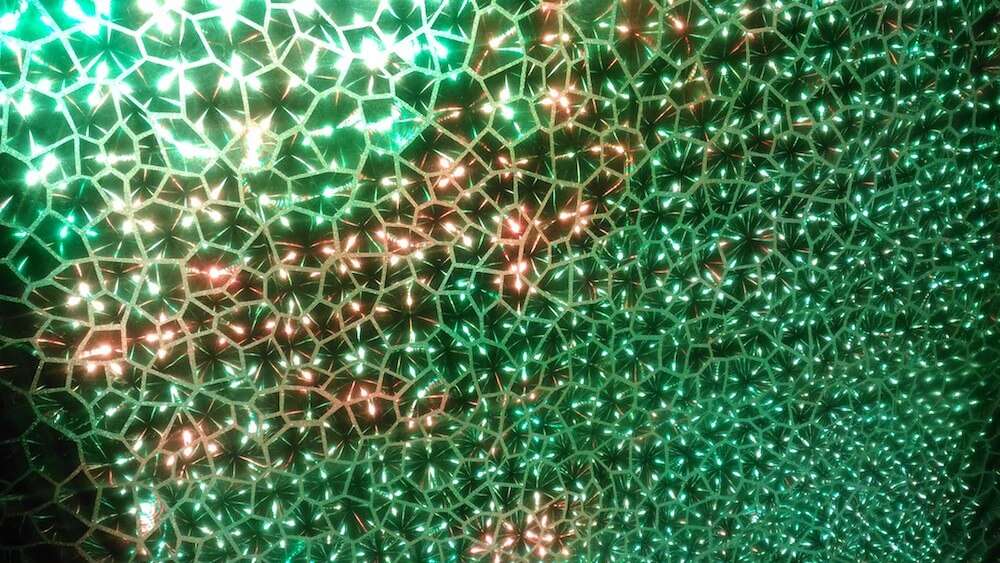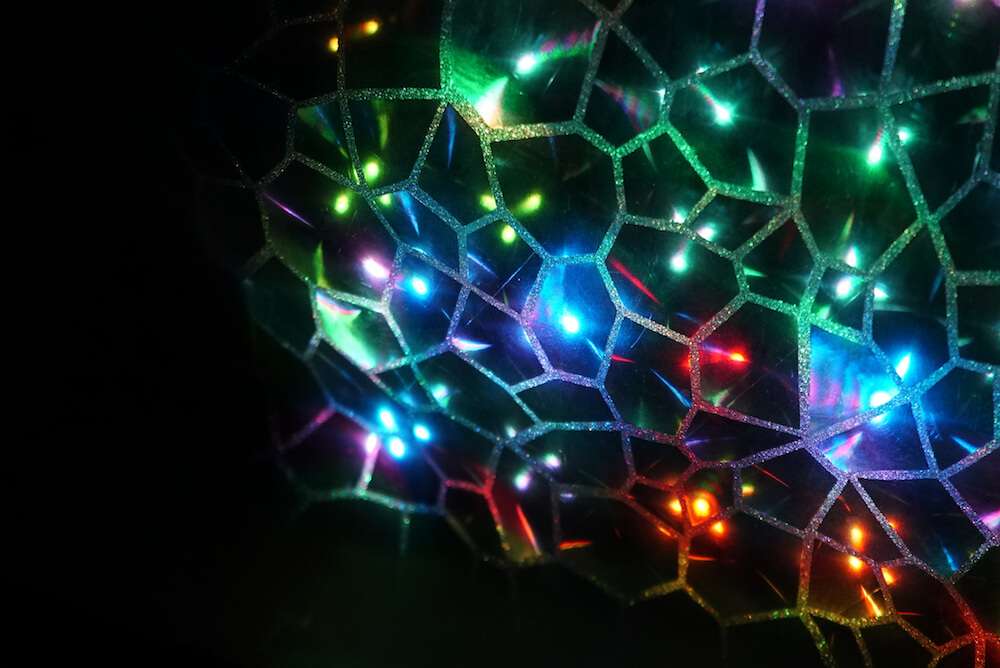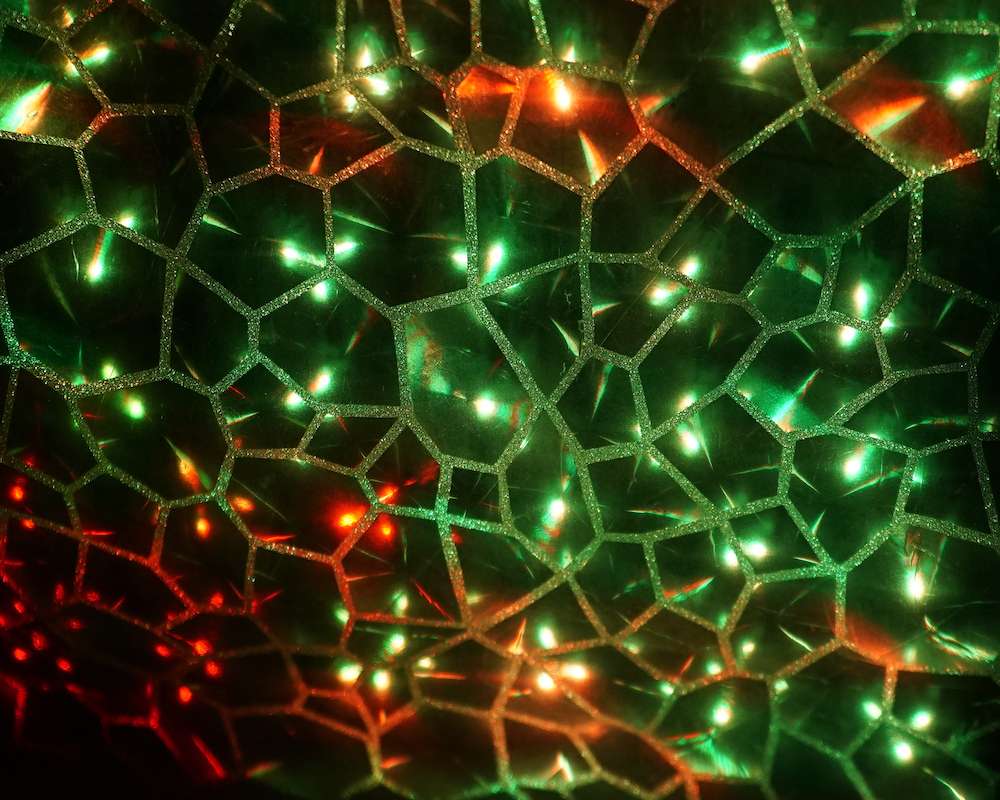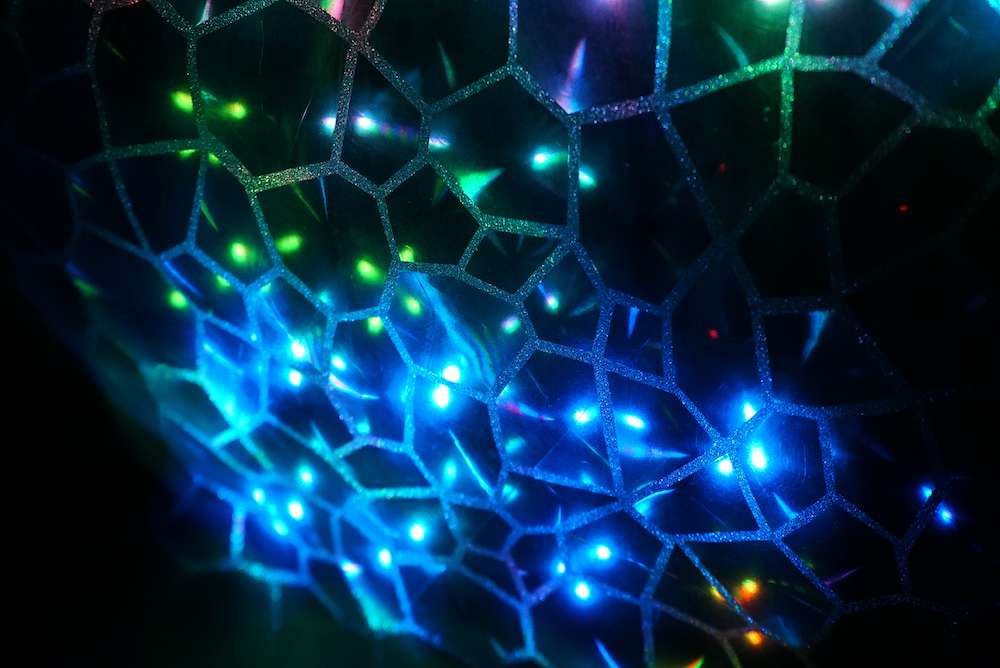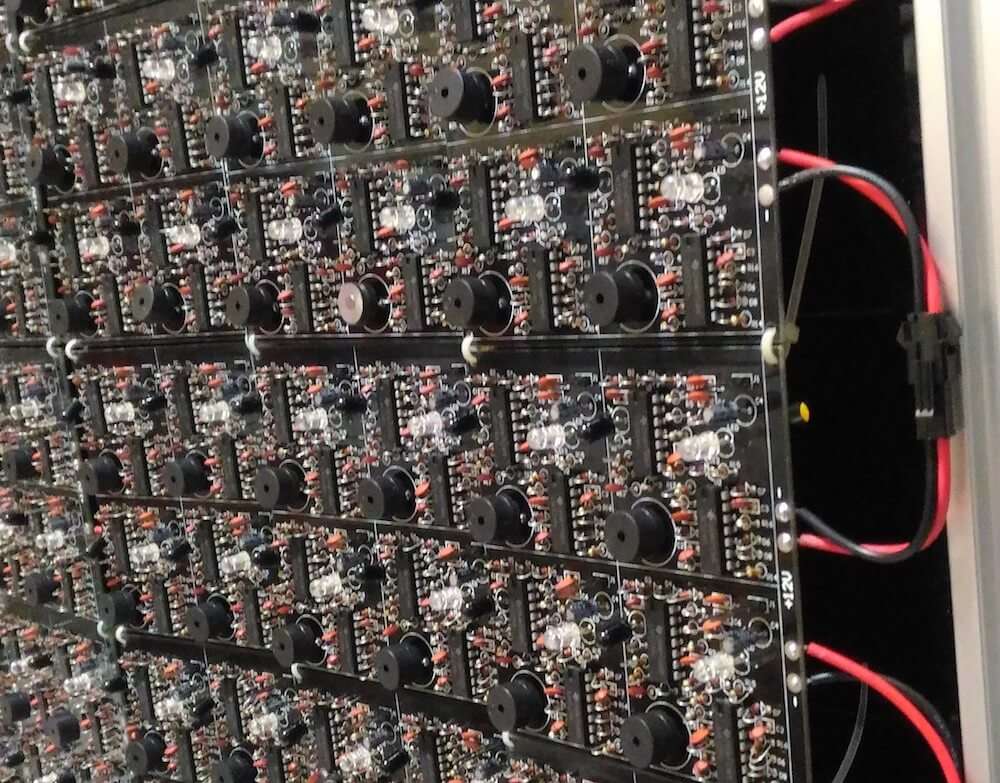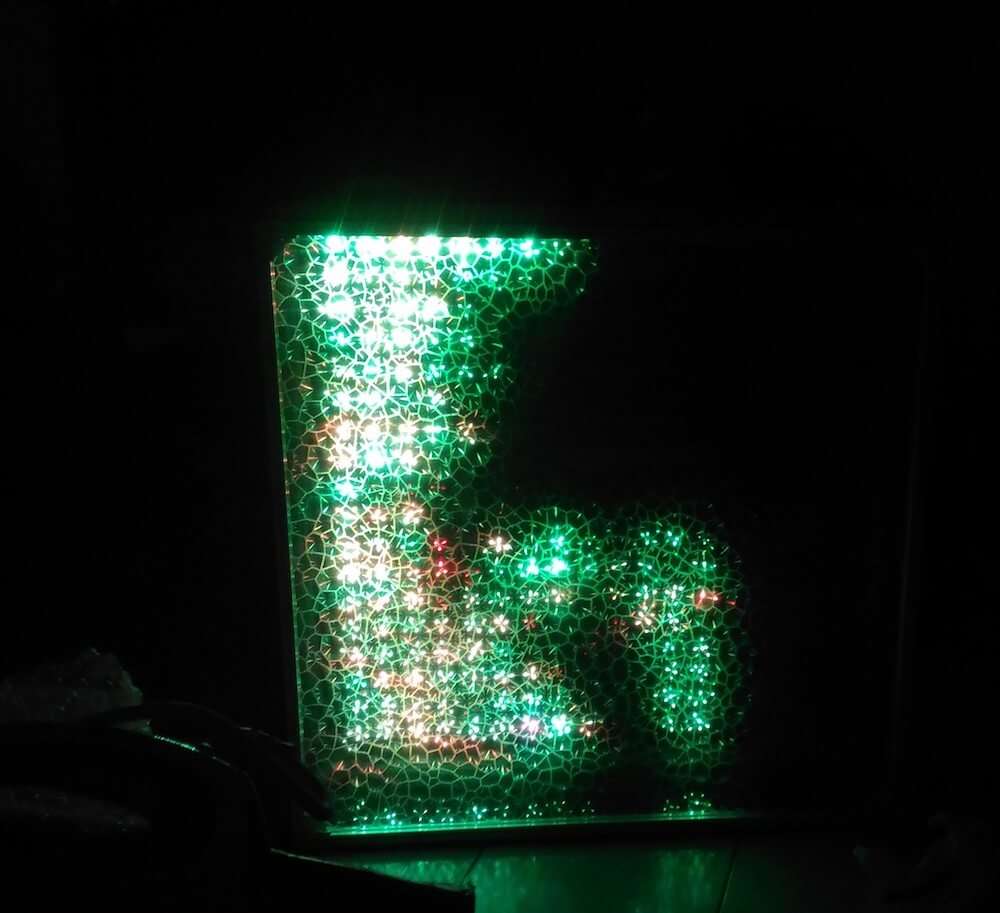Stay True to Yourself: Exploring Interactions with 3D-Printed Ornamentation in Architecture
• Undergraduate Independent Study Project.
• Exhibitor, “Young Voices – Collective Exhibitions from 11 universities”, Taiwan.
• 3D Printing / Microcontrollers / Buzzer / LED Printed Circuit Boards / Infrared Sensors / Photodiode
• 122(H)*244(W)*15(D)cm
Paintings and sculptures have long been used as ornaments for decorating both indoor and outdoor spaces; however, these types of decorations usually remain static and non-interactive. As a result, pedestrians with fast-paced lifestyles rarely pay attention to them, let alone get curious about the concept behind the artwork.
In this project, I have developed an interactive sound and light installation which can be placed on a wall to attract people passing by. As the art responds to a pedestrian’s movement, its changing nature will attract attention. It is like walking in the wilderness, you may find spotted meteorites or rough diamond in the cave. The original pitted stone may not be perfect and immature; however, it is the most precious original state. The messy rustles come with light up and off, which is like some of creatures living inside the lair. In the icy electronic parts, a life seedling is emerging. Audiences will find it entertaining by interacting with the creation. With such a device, the art on the wall will become more than an adornment to the extent that it might be spiritually refreshing to onlookers as a consequence.
INTRODUCTION
Paintings and sculptures have long been displayed or installed on walls as decorative embellishments in public and business locations. Murals, for example, are often employed as an aesthetic element integrated into the environment and marked as true cultural artifacts and even monumental works. Apart from their cultural significance, murals could be created for the purpose of advertising or simply for arts’ sake [1]. These adornments, however, remain largely static and may become boring for their vast similarities.
Recently, there has been an increase in the use of digital display walls [2], such as interactive LED lighting installations [3] that provide audiences with chances to interact and play with them. Nevertheless, interactive walls of this type are usually configured in the form of flat surfaces—monitors or map projections. Once the electricity is cut off, the physicality of decorative objects disappears. To elevate human interaction with solid walls, I have constructed a tangible structure made of 3D-printed plastic and then incorporated it with numerous infrared sensors. “Stay True to Yourself” is an interactive sound and light installation. The lights on the structure that will be switched on by an intuitive interaction when people pass by it. It can also be used as part of the work that allows the human body to virtually “paint” the installation, symbolizing the quest of finding one’s true self.
This piece of work was exhibited in the public area of Chiang Kai-shek Memorial Hall, Taipei, between 28th March and 10th April, 2017 [4] [5]. Approximately, 13,000 tourists from different countries visited the installation over a 9-day period [6]. It was reported on mass media that people found it engaging to interact with the device. The news coverage of the installation can be found on the website of Art TV Taiwan [7] and CBTV internet television [8].
These images indicate how audiences interact with the “Stay True to Yourself” installation. The installation would be lighted up as it is responsive to the contours of the human body drawing near.
DESIGN
Three elements—a beehive-shaped structure, an interactive light effect, and interactive sound have been integrated into this piece of work to the extent that the installation looks like mysterious creatures living within. As people slow down their pace, trying to interact with the device, their interactions with installation will relieve them from their stressful life, awakening them to something new in their environment. Their spontaneous engagement in this lovely wall ornament will help them look at life from a fresh perspective. This will be physically and mentally beneficial to them as a result.
Infrared receiving circuit
Since the infrared receiving (IR) circuit is combined with a photodiode as an IR-receiver sensor, the light from the infrared lamp hanging on the opposite side of the wall will be blocked or interrupted as audiences walk within three meters in front of the installation. As the photodiode on each shielded PCB board of the beehive-shaped structure installed on another wall could not receive infrared light, a signal is then sent to light up LEDs as well as drive buzzers to operate the specific tone.
Figure 1. LED would light up if the audience blocks the infrared light. Otherwise, the LED would be switched off because of receiving infrared light.
Figure 2. The diagram indicates that Protel 99SE has been used for the schematic of an IR-receiver sensor I have designed for the “Stay True to Yourself” installation.
Q1 is a PN-junction photodiode used to detect the light that consists of electromagnetic radiation in near infrared (IR-A: 800-1400 nm or perhaps a little beyond) region [9], which is most sensitive at 940nm wavelength. Resistors in the diagram, R1 and R2, determine the turn-off-delay time of LEDs. Then R3 determines how far apart the infrared lamp and photodiodes can be but can still work together. The entire light-delay time is influenced by capacitor C2. C1 is used to ensure that there is enough power for the circuit when wires connecting each PCB board are too long.
Figure 3. This figure shows the steps when constructing the PCB board of an infrared receiver sensor of the installation. The picture on the top left indicates the layout of the schematic. The picture on the bottom right shows the sensor wrapped by a beehive-shaped lampshade.
Buzzer oscillation circuit
The design procedure is indicated in the PDF.
In order to generate a square wave of the specified frequency (about 1kHz—the loudest for its resonant frequency) on each buzzer, I have designed a relaxation oscillator that produces a periodic signal. Sound is used in this project as a medium to attract people’s attention and interest because it plays a significant role in everyday communicative exchanges. According to The Anstendig Institute, impressions obtained through the senses of sight and hearing are indispensable like food and water for human beings [10]. With numerous buzzers playing this tone, it seems as if several insects or spirits inhabit the beehive installation.
Figure 4. Relaxation oscillator circuit.
The OP-Amp here works like a comparator with no virtual short exists between V+ and Vc . The output is a square wave.
- When V+ > Vc : Vout is close to VDD
- When V+ < Vc : Vout is close to VSS
MECHANISM AND CONSTRUCTION
Figure 5 shows the 3D design of the organic-shaped structure first referred to on page 2. The entire structure is first divided into 26 segments (and then enlarged to twice the number in the final iteration). Each segment is about 30 cm (H)*30 cm (W)*15 cm (D) to ensure that the 3D printer can print it and to be a convenient size to carry around. This size is also flexible and can be enlarged or reduced in size according to the location of the exhibition. After finishing printing the structure, I assembled all the parts so that the final volume of the installation is approximately 122 cm (H)*244 cm (W)*15 cm (D), which is an appropriate prototype size for the human interaction.
Figure 5. The diagram indicates that Meshmixer has been used for the segments of the 3D organic-shaped structure model I have designed for the “Stay True to Yourself” installation.
Figure 6. The pictures above show the process of assembling the 3D-printed segments.
The 3D-printed segments are affixed to the front of a plywood board by threading white cable ties through numerous holes made by an electrical drill. LEDs, photodiodes, and buzzers are visible on the front of a plywood, too. The back of the board features around 200 pieces of PCB board, electrical wires, and power supplies. The installation is subsequently attached to wooden lumber to create a fake wall whose scale is illustrated in Figure 8.
Figure 7. The figure shows the construction of PCB boards and wires behind the “Stay True to Yourself” installation as well as the 3D-printed structure fixed on the front.
The most appropriate distance between the sculpture and audience (for purposes of interaction with the work) is about 4.5—7 meters (roughly 5—7.65 yards), which is enough distance to work anywhere as long as there are wide corridors. There is no need to worry about the installation being destroyed as the interaction does not involve physical contact (though a sign should indicate that physical contact is neither necessary nor permitted in order to engage with the sculpture) and people who want to play with it simply need to move their bodies in front of the creation.
CONCLUSION AND FUTURE WORK
In this project, I have designed a tangible interactive structure that can decorate either an indoor or outdoor location to draw people’s attention to have a break from their daily life patterns. By playing with the installation, passersby might intuitively release themselves from pressures and anxieties to the effect that this structure is not merely decorative but illustrative of how public art installations can be conducive to the mental health of the public. A future iteration of this work aiming for more active interaction might involve more detailed interactive effects. For example, the color of the light and the duration of the sound operated by buzzers could be varied in accordance with the speed at which audiences walk by the creation. If people pass through it at a normal speed, LEDs would light up in green, whereas, if people run past it, the lights would appear in blue. If people make a pause in front of the work and then walk away, the light would turn red. Equally important like the interaction, two other features need to be taken into consideration: to modularize the creation in order to accelerate the assembly process, and to increase the resolution (which depends on where to put it on display).
Figure 8. This figure shows the change between the light color and the speed of pedestrians and indicates the modularized structure of the ongoing research project.
REFERENCES
[1] WIDEWALLS. (2017). “Mural. The History and The Meaning.” [Online]. Available: https://www.widewalls.ch/what-is-a-mural-the-history-and-meaning/.
[2] Mouth Watering Media. (2017). “The Top 10 Digital Interactive Display Walls.” [Online]. Available: https://medium.com/mouth-watering-media/the-top-10-digital-interactive-display-walls-40b96066477c.
[3] ARCHITONIC. (2012). “LivingShapes interactive wall by Philips Lumiblade – OLED.” [Online]. Available: https://www.architonic.com/en/product/philips-lumiblade-oled-livingshapes-interactive-wall/1201916.
[4] Official Website of Department of New Media Art 4th Graduation Exhibition. (2017). “Gazing into the Wilderness.” [Online]. Available: http://newmedia.tnua.edu.tw/bfa/102/gazing/?fbclid=IwAR1enN7Kuz03tM-JcTL-RWWWrZ3RFbcAvZYnBxm2uuRAb2xh9YoHjob2GGg.
[5] Chinese Association of Museums. (2017). “Gazing into the Wilderness.” [Online]. Available: https://goo.gl/M1rvWD.
[6] Department of New Media Art 4th Graduation Exhibition. (2017). “Gazing into the Wilderness.” [Online]. Available: https://www.facebook.com/2017GazingIntoTheWilderness/posts/1270887299626904?__tn__=-R.
[7] Art TV Taiwan. (2017). “Young Voices – 11 Universities’ Exhibition.” [Online]. Available: https://wantinghsieh.com/wp-content/uploads/2017-Young_Voices–Collective_Exhibitions_from_11_universities-report.png
[8] CBTV internet television. (2017). “Gazing into the Wilderness.” [Online]. Available: https://www.youtube.com/watch?v=WeAFR1tEnBU#t=01m15s.
[9] James Bryant. (2014). “Photodiodes and other Light Sensors.” [Online]. Available: https://wiki.analog.com/university/courses/electronics/text/light-sensors-photodiodes.
[10] The Anstendig Institute. (1988). ” The Important of Sound in Our Lives.” [Online]. Available: http://www.anstendig.org/ImportanceOfSound.htm.

